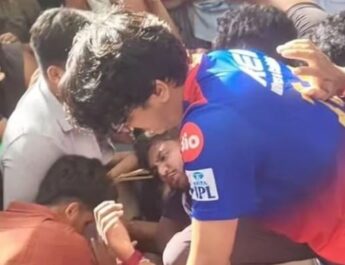Kannada director Prashanth Neel’s film KGF-2 is released. Superstar Yash’s film is based on gold mines located in Kolar, Karnataka. You may have seen the first part of KGF, but you hardly know the real story of the mines of Kolar.
Today we are telling the real story of KGF. Who discovered gold here? How did the excavation begin and for how many years did it continue? How much gold came out of these mines and where is it today? In what condition is KGF today? So let’s start with the location of KGF…
KGF stands for Kolar Gold Fields
Kolar district is located in the southeast region of Karnataka. Robertsonpet is a tehsil, 30 km away from district headquarter. There is a gold mine here. Kolar is about 100 km from Bangalore. The Kolar Gold Field is the second deepest gold mine in the world, the first being the Poneng Gold Mines of South Africa. Which is located southwest of Johannesburg in South Africa.
People used to dig out gold by hand
British government lieutenant John Warren had heard the legends of the Chola dynasty that people used to dig gold by hand. Impressed by this, Warren told the villagers that the one who will show gold from this mine will be rewarded. In the greed of getting the reward, the villagers brought a bullock cart full of mud in front of Lieutenant Warren.
When the villagers washed the soil with water in front of Warren, traces of gold were seen in it. At that time, Warren got about 56 kg of gold out. A lot of investigation was done from 1804 to 1860, but nothing much was done. Many people lost their lives due to this research. Due to which excavation was banned there.
Research started again in 1871 in Kolar
Michael Fitzgerald Llewelly, a retired British soldier who came to India from New Zealand, was very excited about the Kolar Gold Fields after reading a report published in the ‘Asiatic Journal’ in 1804. He thought why not start it? Levelli decided to stay in Bangalore. In 1871, Leveli traveled by bullock cart for about 100 km. During the journey, Levelli identified mining sites and was successful in finding gold deposits.
Leveli sought a license to conduct mining in Kolar in 1873 from the government of the Maharaja of Mysore, after completing two years of exploration. On 2 February 1875, Llewelly got the license to mine, but Michael Llewelly did not have much money, so he looked for an investor and the work of mining fell into the hands of John Taylor and Sons, a large British company. Much of his time was spent raising money and preparing people to work. Eventually the work of extracting gold from KGF started.
India’s sixth place in gold production in 1905
John Taylor and Sons took over the mining operation in 1880. ‘State of the Art’ Mining Engineering Equipment installed. The equipment installed by him in 1890 lasted till 1990 i.e. was operational for 100 years. In 1902 KGF used to extract 95 percent of India’s gold, in 1905 India was sixth in the world in producing gold.
There used to be big problems in gold mining
Mining operations in the 1880s were extremely difficult. Earlier, there used to be light only in selected places, so there was no lift anywhere. There were sharps to go into the mines, which were supported by wooden beams. Despite this, sometimes accidents happen here. It is believed that 6000 people died in 120 years of operation.
To meet the shortage of light in the Kolar Gold Fields, the Kaveri Electricity Station was built at a distance of 130 km from Kolar. This power plant was the second power station in Asia and the first in India. After getting electricity, the work of Kolar Gold Field doubled. This center was constructed at Shivanasamudra in Mandya district of Karnataka. Due to gold mining, KGF started getting priority instead of Bangalore and Mysore.
Kolar was called Mini England
After the gold mining started in Kolar, the appearance here changed. Along with mining, development also came here. Here bungalows, hospitals, golf courses and clubs were built for British engineers, officials and others around the world. The place was very cold and there people started building houses in British style. With this construction, KGF started to look like Mini England.
But for those who worked in the mine, the situation was not like England. He lived in Coolie Lane, where facilities were few. Many families lived in the same shed and their life was very difficult. This place was famous for the attack of rats. It is said that the workers living here had killed about 50 thousand rats in a year.
Government control over KGF in 1956
In 1930, about 30 thousand laborers used to work in Kolar Gold Field. When the gold reserves in KGF started depleting, the workers also started leaving Kolar. Although KGF was occupied by the British till independence, but after independence in 1956, the central government decided to take control in its hands. At the same time, the ownership of most of the mines was handed over to the state governments.
The mines that produced 95% of India’s gold were nationalized to avoid closure. By 1979, there was a lot of loss and they were not able to pay even the wages of the workers. The Kolar Gold Fields was closed in 2001.




